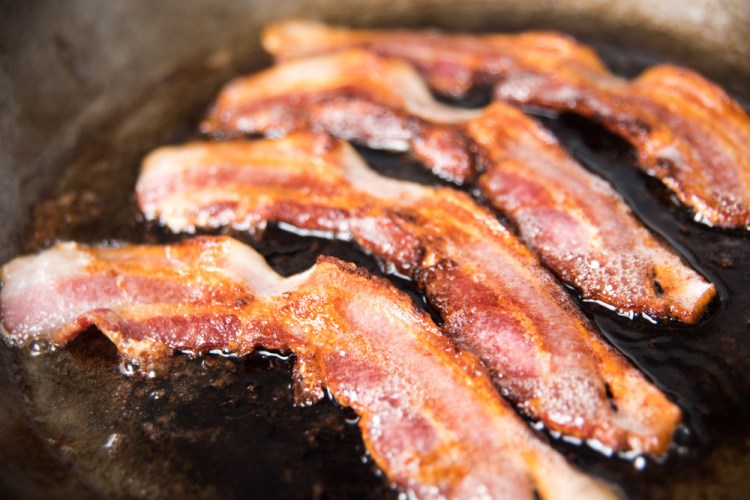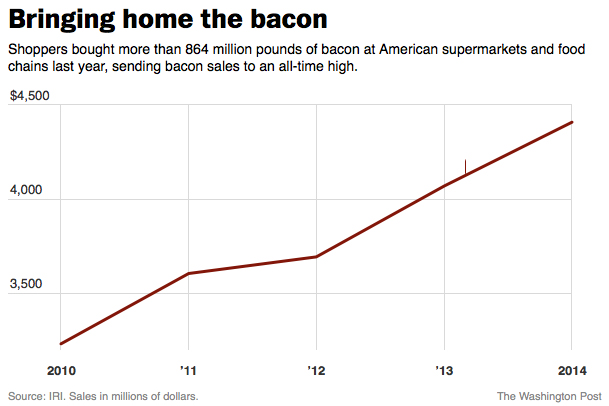Pizza chain Little Caesars this week unveiled a deep-dish pizza wrapped with more than three feet of “decadent” thick-cut bacon. A day earlier, Starbucks debuted its own bacon-y surprise: a 540-calorie double-smoked bacon breakfast sandwich “sure to satisfy any bacon lover’s craving.”
There was a time years ago when bacon was one of America’s most inescapable fad foods, the star of an increasingly wacky line of dishes with its own cult-like following. But the bacon backlash was swift, with some saying the cured-pork craze had “gone too far” and was “officially dead.”
Yet even after a devastating 2014 for the pork industry — when an epidemic diarrhea virus killed millions of pigs and drove prices to new records — the unstoppable business of bacon retained its place as one of the best-selling meats in America.
Now, with the outbreak under control and hogs back in heavy supply, pork prices have plummeted, leading analysts to make a new prediction: Americans can expect even more bacon debuts at big restaurants in the months ahead.
“Last year we had record prices, and still consumers bought those products,” said Steve Meyer, the president of industry researcher Paragon Economics and a consulting economist for the National Pork Board. “Given where pork prices are now, that’s going to open some wonderful values for putting new kinds of bacon dishes in restaurants.”
American bacon sales have soared for five straight years, climbing 8 percent to an all-time high of $4.4 billion last year, data from Chicago-based market researcher IRI shows. More than 864 million pounds of bacon were sold last year at America’s supermarkets, retailers, convenience stores, drugstores, military commissaries and dollar chains.
That came during a year when the deadly pig virus, known as PEDv, devastated stock and drove hog farmers to slaughter, sending the average price for a pound of sliced bacon to around $6.10 last summer, a 30-year high, federal data show.
Widespread vaccines and sanitized farms, coupled with efforts to quickly breed and feed more hogs, led to a rebound last year in pigs healthy and ready for sale, leading retail prices to fall ever since.
“We’ve gone from ‘We’re going to run out of pork!’ to ‘What are we going to do with all of this meat?’ ” John Nalivka, president of agricultural-advisory firm Sterling Marketing, told the Wall Street Journal.
A different kind of virality for bacon has long served food giants: its success as a social-media marketing tactic. Increasingly strange, limited-time-only stunt foods became a fast track for restaurants looking for national attention, and bacon, with its cult-like fandom, proved a versatile, time-tested star.
You could get bacon in Burger King sundaes, Red Robin milkshakes, Ritz crackers and Pillsbury Toaster Scrambles. And that was just the food: You could also buy bacon air freshener, candles, toothpaste, vodka, shaving cream, perfume, soap and lubricant. Unlike other food fads, bacon proved to have incredible sticking power. Wendy’s 970-calorie Baconator, launched to fanfare in 2007, got so old it had a son.
Attention-grabbing bacon unveilings became so commonplace they seemed to backfire, but years of death watches for the bacon trend were routinely proven wrong (“The Bacon Mania has Gone Too Far,” 2009; “I think we can pronounce the bacon trend officially dead,” 2012).
The bacon business has remained mostly protected from the consumer trend toward healthier cuisine. America’s push for protein and trendy eating fads like the Paleo Diet have even helped; market researcher Technomic called pork “the latest protein star” last year.
But the pork industry has said its lasting legend as an indulgent, traditional treat has helped it outlast any short-term craze. “The silly stuff is over with,” Patrick Fleming, director of retail marketing for the National Pork Board, told Modern Farmer. “But bacon keeps growing.”
As for the Little Caesars bacon-wrapped-crust pizza — which is also sprinkled with bacon — it will sell for $12 between Feb. 23 and late April. A slice would pack 450 calories, 23 grams of fat and more than 800 milligrams of sodium.
(“It is indulgent, but compared to MANY other products in the industry it’s not half bad,” spokesperson Tina Taylor wrote in an e-mail. “One slice has less calories than a quarter pounder with cheese from a certain fast food chain. Just a thought.”)
“With the new Bacon Wrapped Crust DEEP!DEEP! Dish we’re pushing pizza to its bacon limits,” Edward Gleich, the pizzeria’s senior vice president of global marketing, said in a statement. “It’s unabashedly delicious. That’s why we like to say, ‘In Bacon We Crust!’ ”
The pork industry, for its part, is not exactly worried over a new bacon backlash.
“I saw a thing a few months ago that said, ‘The bacon thing is over, its gonna go away,'” said Meyer, the Pork Board’s consulting economist. “My thought was: Gee, when did bacon stop tasting great?”
Send questions/comments to the editors.




Comments are no longer available on this story